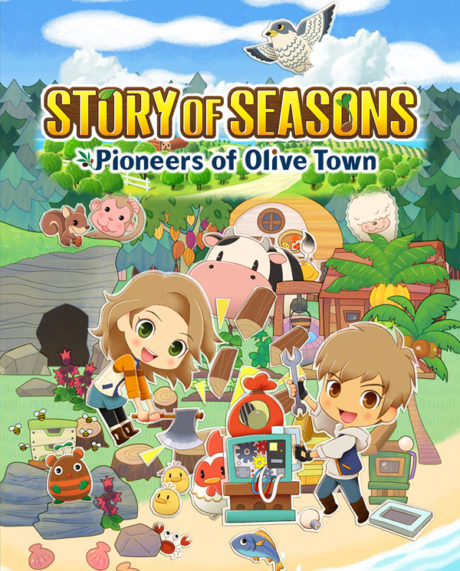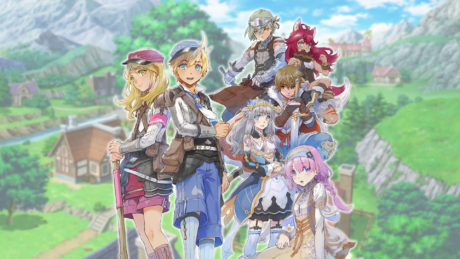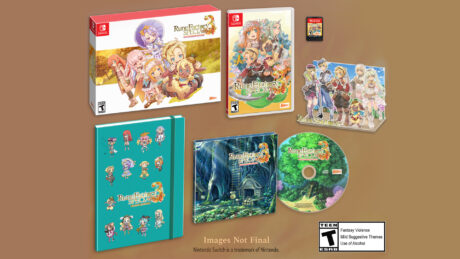Purrr....
- Gameplay freedom and tranquility
- Near-limitless content/gameplay
- Whack-a-mole
- Wholesome relationships
Hisss!
- Repetitive chores
- Stamina usage/limits
- Store hours/availability
Platform
SwitchPublisher
MarvelousDeveloper
MarvelousSeries
Story of SeasonsGenre
RPG, SimulationPlayers
1File Size (Minimum)
3.4 GBRelease Date (NA)
Mar 23, 2021Story of Seasons: Pioneers of Olive Town is a game developed by Marvelous and released in North America by subsidiary XSEED Games. While the game has its roots in the Harvest Moon series, that series proceeded in two similar directions with subtle differences, in the form of the titles Story of Seasons (known as Bokujo Monogatari in Japan) and Harvest Moon. Story of Seasons: Pioneers of Olive Town is set for release on the Nintendo Switch on March 23, 2021.
The title features simulation-based farming gameplay in which the main character has to restore a family farm, located in Olive Town, back into its former glory. Plant crops, raise animals, and build relationships as the main character to resurrect and grow the farm. Utilize tools and machinery, explore caves, and fulfill tasks to improve Olive Town, and make you and the townsfolk prosper.
Story of Family Farm Revival
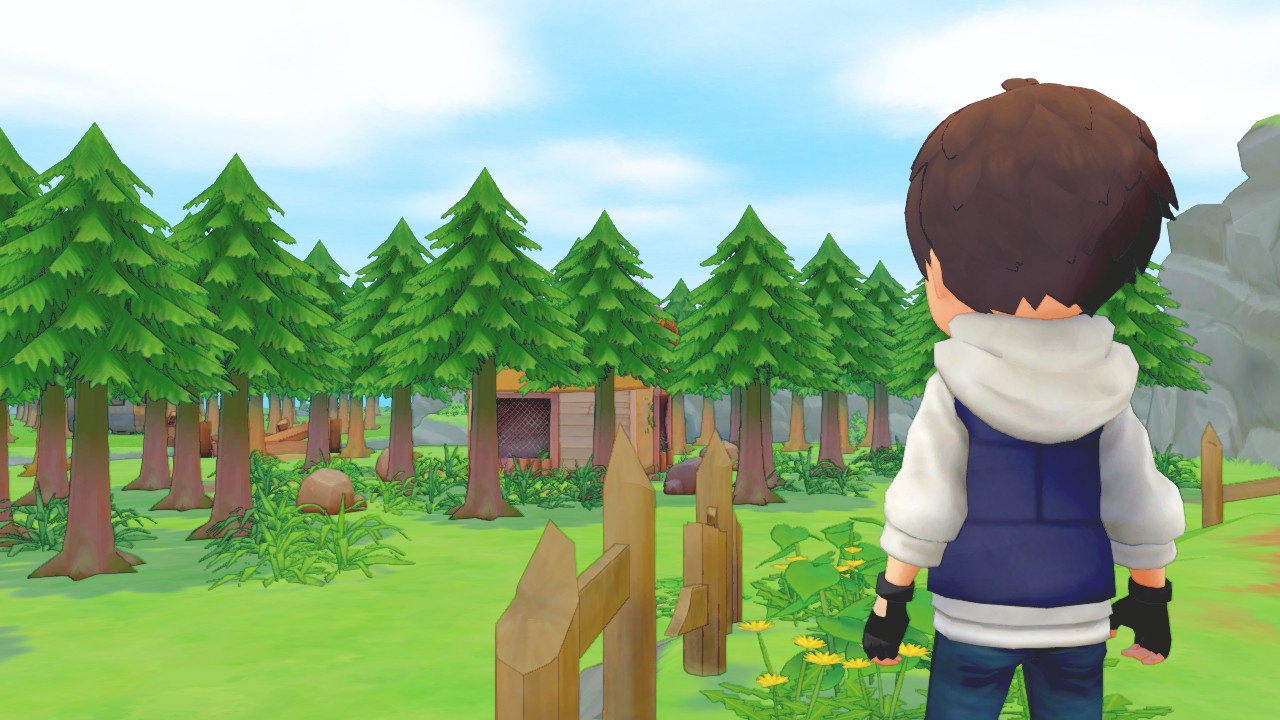
The story starts with a main character whose grandfather established the small, peaceful community of Olive Town and left a farm within the family. Early in the game, the mayor of Olive Town, Victor, provides guidance on how to restore the family farm by clearing trees and overgrown grass and raising crops and livestock. Victor provides the main character with a series of tasks and choices which will help develop the infrastructure of the town while providing additional resources for the farm.
The gameplay focuses on relationship development and task-based expansion of the farm via repairing bridges and barns and cultivating a landscape full of crops. Tame animals found along the way as the farm expands, including chickens, cows, alpacas, sheep, domestic pet dogs and cats, and also a horse to ride around on. Explore the caves for valuable resources, such as minerals and ores, or chop down trees for various types of wood which are instrumental in the building and repairing of the farm. Experience the changing time and seasons while adapting to the needs of the farm during those times.
Stamina and Season of Time
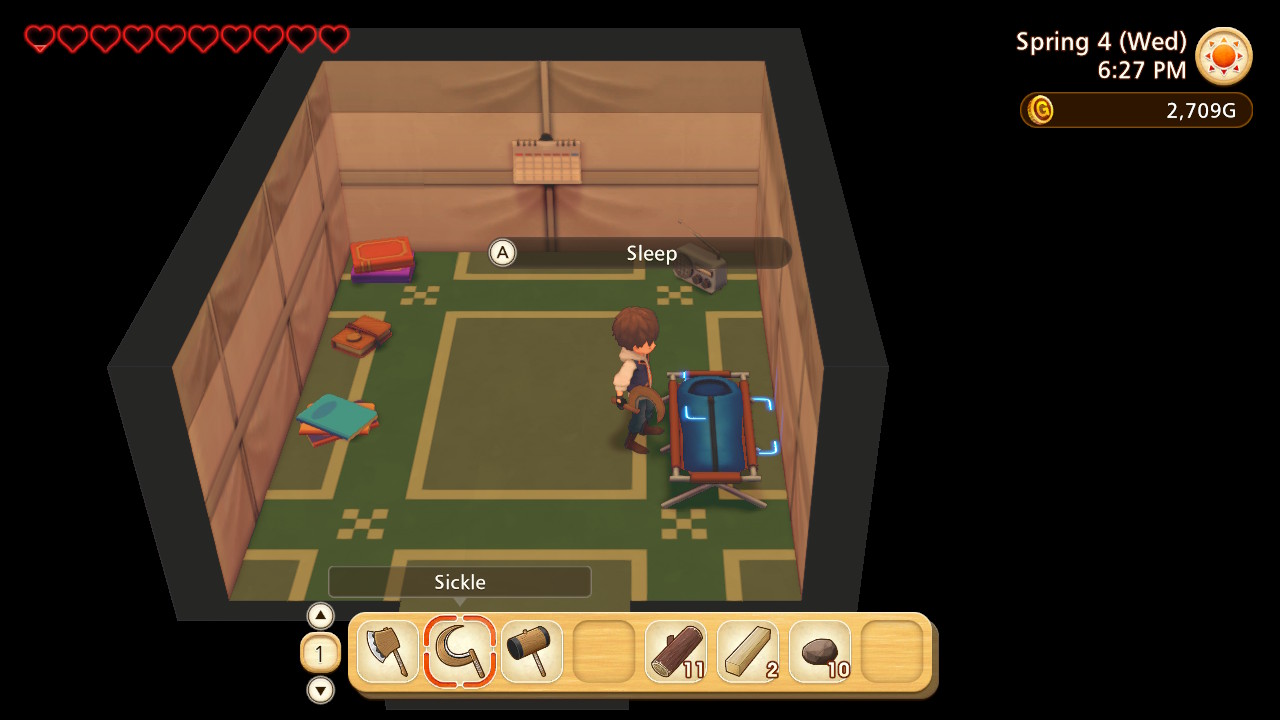
While it is an interesting feature, the main character has ten stamina hearts which decrease as actions are performed, such as building, cutting down trees, or watering plants. Certain tasks consume more stamina hearts than others and pairing the correct upgraded tool to the resource type reduces consumption. When the hearts drop to zero, the character passes out and automatically returns home. Upon waking, a new day arrives, sometimes without a fully restored number of hearts, which raises the important concept of resting in bed before passing out to ensure full health for the next day. Certain meals and food items, such as milk or wild berries, restore a limited amount of hearts if you need to stretch a day a bit further. However, eating food creates a tricky situation, since it can be difficult to know when the character will pass out exactly. It requires monitoring the character’s comments as well as the hearts that show when the character is about to pass out.
Outside of limited stamina, time flows rather fast through the day, which can make it challenging to get tasks done. This style of gameplay helps prevent users from rushing and forces a prioritization of tasks for the day, such as a cave mining day, clearing trees day, and daily animal and crop activities. The seasons pass after a certain number of days have elapsed, and spring, summer, autumn, and winter each have preferred crops and events. Other that that, there are two difficulties in the game, similar to previous entries in the series: normal mode, which is geared toward average-to-veteran gamers, and seedling mode, which is geared toward casual gamers by changing the stamina usage and lowering the requirements of tasks.
Farming Tools
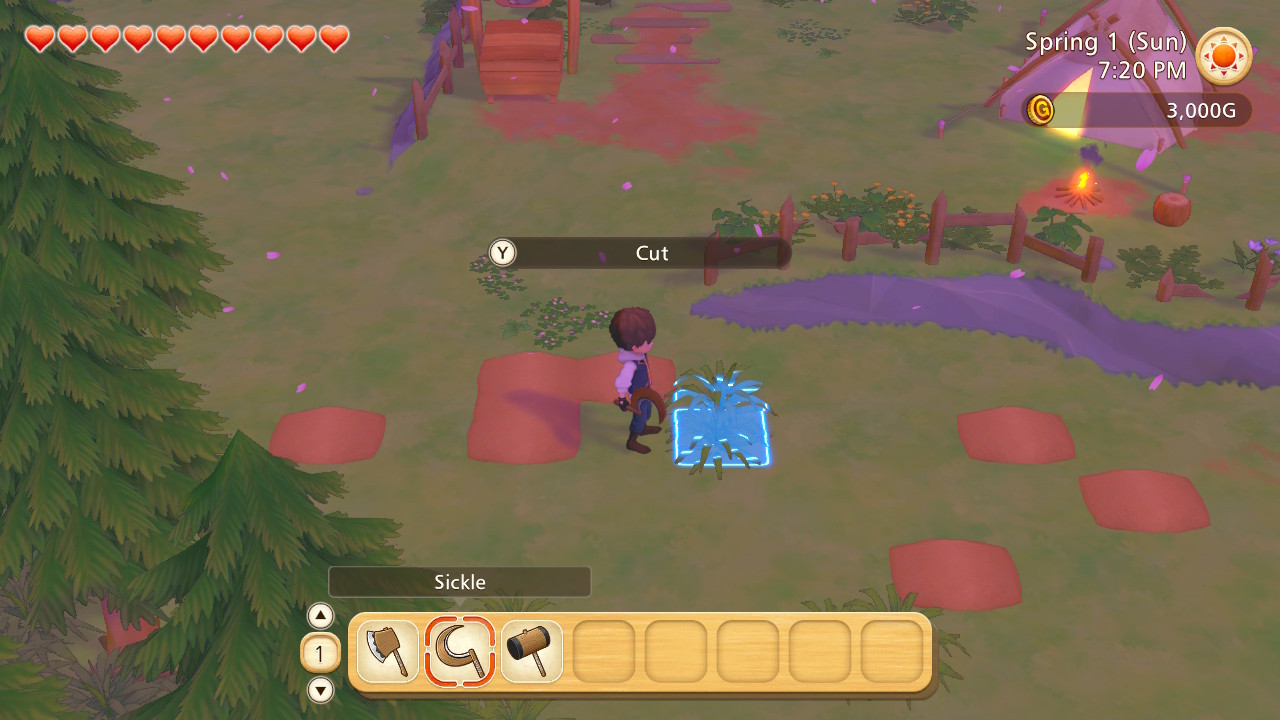
There are a finite number of tools available that each help with different tasks, such as an axe for cutting down trees, a hammer for mining, and a tiller for getting the land ready for seeds. These tools can eventually be upgraded with money and resources. The upgraded versions make it easier to efficiently perform tasks, and later tool upgrades open up a charge-up skill which allows for the use of the tool over a larger area. When a target is highlighted, the game will prompt you with a button to press if you want to perform that particular task. This feature is helpful for less common tasks like clearing away dead plants that tried to grow outside their season. Fortunately, incorrectly performing the action does not consume stamina, which helps those new to the game.
Farming tools take up a spot in your backpack when in use. Thankfully, the backpack can be expanded through in-game money and even features a separate, dedicated tool bag to stash tools in to free up space on the go. Additionally, each tool has a corresponding leveling-up category which improves the efficiency of the tool, unlocks building recipes, and/or provides rewards such as a mineral ore or fence with each milestone. One valuable, craftable item is a storage bin that allows the character to retain more of the resources around the farm.
Later in the game, some tools naturally become less useful. For example, watering cans are superseded by a sprinkler system, a huge quality-of-life feature that waters nearby plants every morning. Similarly, water pails are replaced with a suction drainage device that easily empties water from large ponds. Draining a larger pool of water will reveal a treasure chest with one or more bags that can be taken to the museum for identification and appraisal.
Cash Crops

A staple in this game is preparing the land for the sowing of each plant’s seed. Each plant varies in the cost of seeds and the selling price, as well as the time it takes to grow. For example, corn can take 8 days to harvest and sell, whereas others can take only 4-5 days. Also, each plant has desired seasons to be grown in, such as corn for summer and autumn; otherwise, the plant will wilt. Plants have to be watered daily to progress through their stages until they are ready to be harvested. Certain plants, such as tomatoes or cucumbers, can produce a harvest for up to three cycles. Crops can be sold as is or used in certain cooking recipes to restore stamina hearts. Winter tends to be a slower season in terms of crops, requiring cash production in other areas (think livestock).
Among the notable crops and resources are mushrooms, which are grown using seeds on a log but do not need to be watered. Additional mushroom logs can be purchased in town to help with production of the farm. Another unique resource, production-wise, is the beehive box which produces honey, a feature which is unlocked later on as the farm expands.
Crafting Your Farm
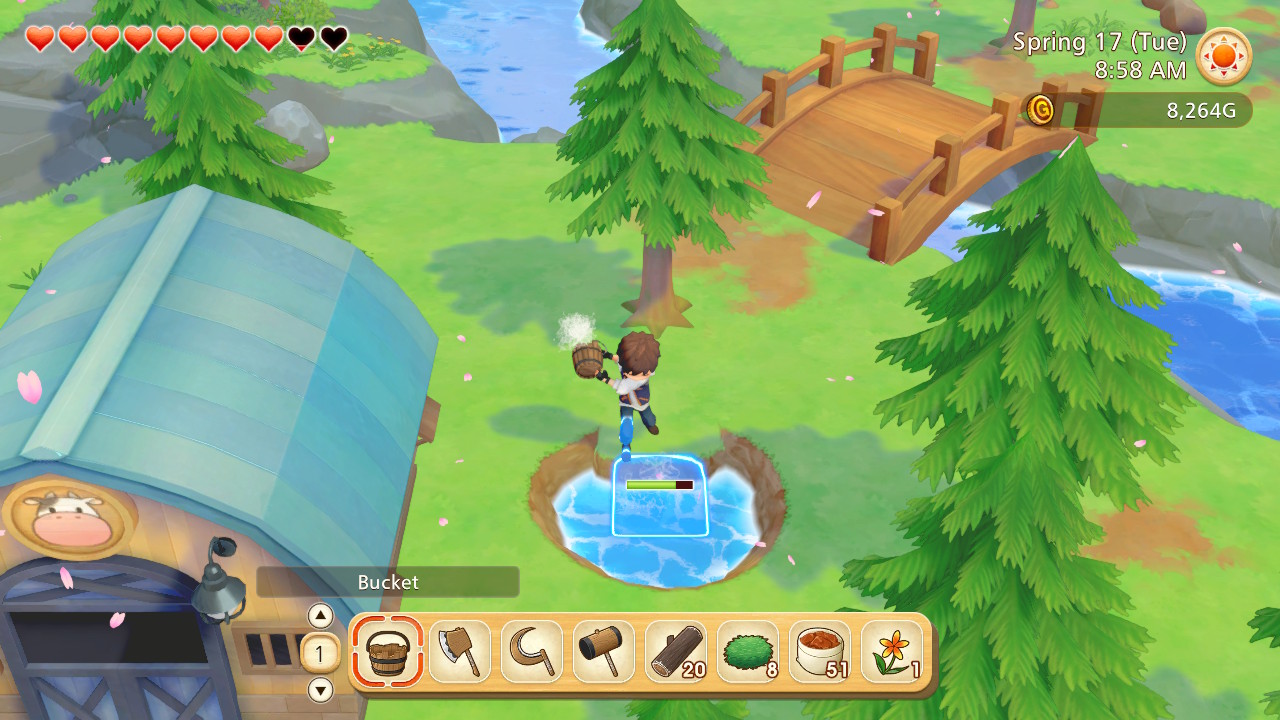
When you start out, numerous structures on the farm are broken and in need of repair. Repairs can be done using one of two methods: by gathering resources, such as 50 sturdy logs, 30 mortars, or 10 silver bars, or by simply spending enough money on repairs. These structures are vital to the farm’s growth, from barns and stables, which allow for the taming of cows or horses, to ramps and bridges, which increase the farm’s overall size. Fortunately, the difficulty for repairs is set just right to prevent the character from rushing through content while not making it overly challenging. Within one of the town stores, barn space can be expanded or new barns can be purchased, though doing so requires a certain amount of money and resources.
Outside of repairs, various recipes can be unlocked during the game for crafting purposes and utilized via the menu screen to build machines that change resources such as milk to cheese, create fences and pathways to decorate the farm, and craft resources needed for production or repairs such as coal to refined coal. Machines are incredibly useful for converting resources into usable forms, such as changing clay into bricks or silver ore into silver bars, which are a staple for tool upgrades, repairs, and recipes. Each machine task varies in time, with silver bars (4 hours) taking longer than iron bars (2 hours). Many times, it is useful to have more than one of certain machine types to speed up production. The game is helpful in this regard, sometimes rewarding you with a second one when certain titles are earned.
Animals and Moo-re
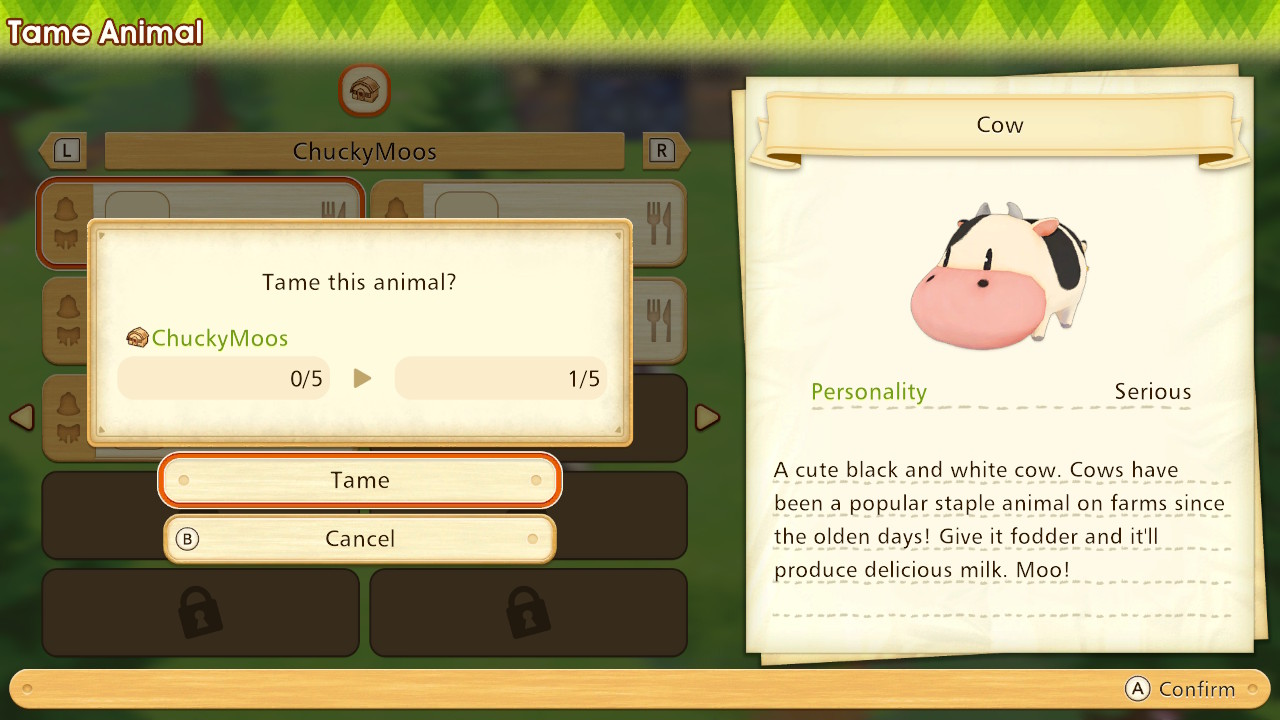
Of course, what would a farm be without animals? There are a myriad of animals in the game with some able to be tamed, such as cows and chickens, and some not, such as squirrels and foxes. With the untamable animals, the character can use the camera tool to capture them on film and turn the photos in to the museum for display. In general, tamable animals produce items that can be combined or transformed into another resource, such as turning eggs into mayonnaise, or outright sold for money. Many farm animals require restocking the animal’s barn feeding troughs with fodder, which can either be purchased or grown from seeds. Up to ten fodder can be stacked in the barn, and can last several days, but it also depends upon the number of animals in the same barn (limited to a max of five per barn). Item production requires a basic task action to gather the resource, such as milking a cow, gathering chicken eggs in a barn, or shaving the sheep or alpaca for wool.
One of the more unique animals is the pet dog or cat. They can be found near or within the home on the farm, and relationships with the pet can be nurtured. By taking them on walks and by feeding treats to them, you can develop a strong bond. There is also a pet event in Olive Town where the character’s pet can race against the pets of other towns folks. You’ll also see a wild horse. Later in the game, the character can unlock a special stable that allows it to be tamed. Then, you can ride the horse around the farm.
Stores and People Galore
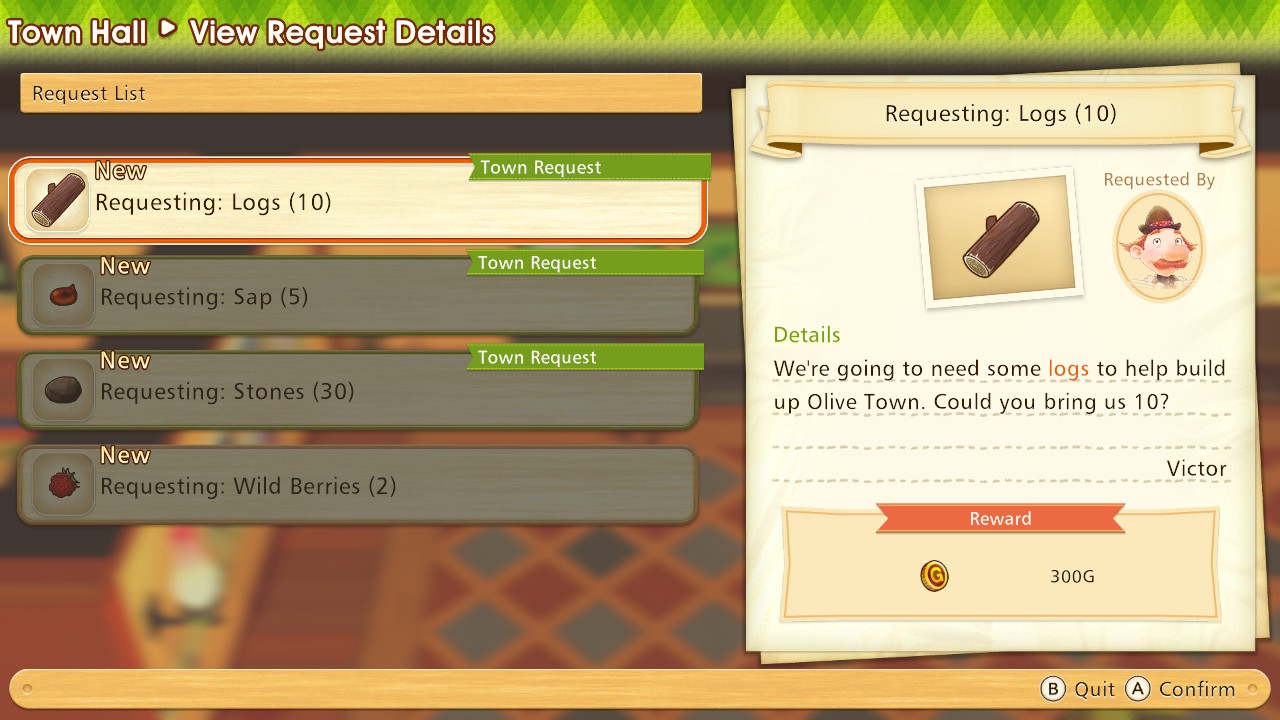
When you need to be around more than just animals, head into town. There are countless stores to visit and interact with in Olive Town, such as a General Store, Beauty Salon, Museum, Town Hall, Animal Shop, Tool Shop, and more. Each store provides valuable resources for purchase and/or NPCs with which to interact. For example, the General Store is the place to go for purchasing seeds, fodder, and furniture, whereas the Town Hall offers special quests to improve Olive Town itself, earn extra cash, or redeem earned titles for rewards. Each store has its own hours as well as off days, so be sure to pay attention. Certain town events such as the easter egg hunt or pet races that will limit access to all the stores for set up and clean up on the day of the event. Unfortunately, certain stores that play an important role, such as the General Store for seeds, seem to have more limited access. Due to the flow of time on the farm, it is easy to finish day-to-day tasks and need seeds after the store is closed. Since crop production plays an important role, the limited ability to stash seeds early on in the game due to cash flow can toss a wrench into production for a few days.
One important aspect of the game is building relationships with the townsfolk. Under the menu option, there is a tab which highlights your growing relationships, making use of a heart system that fills up the more you interact with the townsfolk, such as talking with them or giving them a gift. There are unique events (more than 200!) with dialogues that can occur with each completed heart. Eventually, when the hearts completely fill up for one of the ten eligible bachelors/bachelorettes in Olive Town, the character can propose to and marry that person. On the Japanese site for the game, it has been confirmed that same-gender marriage is possible through a best friend ceremony.
Tis the Season to Explore

While the farm itself will keep the main character rather busy day to day, there are numerous other areas to explore. There are several caves to explore with rich minerals to gather. After the first cave, which has about 7 floors, the following mining cave has up to 30 floors, and the difficulty goes up from there in later caves. Rocks have to be cleared to reveal the ladder to the next floor underneath, and appear to regenerate daily, which can re-block the ladder to the next floor. While the idea of exploration may seem straightforward, it can be challenging to balance your normal stamina expenditure alongside pesky moles that may pop up out of the ground, causing the character to lose even more. Harkening back to the days of arcades, the character is able to defeat those pesky moles in a simple game of whack-a-mole, which drops a reward such as ores, stones, or berries and gets easier with a charged-up and/or upgraded hammer.
Outside of the caves, there is a sprite world, a small location you can visit upon talking to the sprite on your farm. You can utilize the bouncing tokens found during day-to-day farming tasks here to assign sprites to gather resources such as lumber, fish, livestock production, etc. These resources can be allocated up to the number of bouncing tokens found, and once a certain time window has passed, resources as well as sprite currency can be acquired. The sprite currency is used at a special vendor in the sprite world that carries limited basic resources, such as coal or wood, and even new crops and plants to unlock in the General Store in Olive Town. Interestingly enough, there are also unique locations in the sprite world with playable minigames available, such as a beanstalk area up high where you can play a memory-based game that has you digging up gold objects while avoiding the beanstalk tiles. These minigames net the character sprite currency to use at the sprite shop. Some of the other sprite world locations feature a small volcano area or an ancient lake that can be drained for treasure rewards.
Living the Simple Life

Visually, the game has fairly simple animated and colorful graphics throughout. Similar to other games in the same genre, it can be difficult to locate objects behind trees, buildings, and other large structures. Thankfully, the game has a great camera feature that allows it to wiggle side-to-side to see behind objects while also showing a faint silhouette of the object. Olive Town itself is expansive and very detailed with a seaside area, outdoor café seating, and wide, gray, stone pathways connecting each of the shops.
Music in the game is soothing and appropriate for the style of gameplay. For example, one might hear a melody played by a classical guitar with a string chord rhythm backing while in the cabin on your farm or a lively, upbeat, rhythmic synthesizer/drum instrument with a trumpet-like horn/synthesizer melody. Additionally, there are numerous sound effects to add to the complexity, such as clucking chickens, a bell ring to call animals out to pasture, bugs buzzing, or water flowing through a stream or crashing onto the shore.
Harvest Your Own Way
Story of Seasons: Pioneers of Olive Town is a great addition to the series and offers near-limitless farming gameplay. While it may appear chore based and impeded by limited stamina early on, the weapon upgrades, machines, and sprinklers offer greater freedom to get the job done, and the increased breadth of available activities ensure that there’s always something different to do. Overall, it is a peaceful and wholesome experience that can be enjoyed by casual and veteran gamers alike. So come on down to Olive Town, and have yourself a good time.
